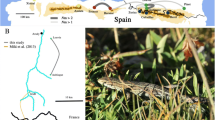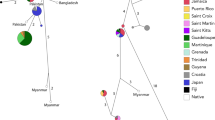Abstract
The masked palm civet Paguma larvata (Carnivora: Viverridae) in Japan has been phylogeographically considered an introduced species from Taiwan. To reveal the population structures and relationships among the P. larvata populations in Japan, seven compound microsatellite loci were isolated from the genome and genotyped for 287 individuals collected from the field. STRUCTURE analysis and factorial correspondence analysis of genotyping data revealed that animals from Japan were divided into four genetic clusters. Geographic distribution of the genetic clusters partly referred to sampling areas, indicating multiple introductions into distinct areas of Japan or independent founding events leading to the generation of different genetic clusters within introduced populations in Japan. The large genetic differentiation of populations in the Shikoku District from those in other areas within Japan suggests that there were at least two introduction routes into Japan, and a possibility that some founders from areas other than Taiwan were also involved in the introduction into Japan. The genetic variation within Japanese populations were not markedly reduced compared with that of Taiwan. The results indicated that the Japanese populations of P. larvata could have retained moderate genetic diversity during founding events, because of multiple introductions, or a large number or high genetic diversity of founders. Although some individuals in Japan showed a sign of admixture between different clusters, there is no evidence that such an admixture markedly increased the genetic diversity within Japanese populations.




Similar content being viewed by others
References
Belkhir K, Borsa P, Chikhi L, Raufaste N, Bonhomme F (1996–2004) GENETIX 4.05, logiciel sous Windows TM pour la génétique des populations. Laboratoire Génome, populations, interactions. CNRS UMR 5000, Université de Montpellier II, Montpellier (France)
Benzecri JP (1973) L’analyse des Donnees: T.2, L’analyse des correspondences. Dunoud, Paris
Chen JP, Andersen DH, Veron G, Randi E, Zhang SY (2008) Isolation and characterization of polymorphic microsatellite markers for the masked palm civet (Paguma larvata). Biochem Genet 46:392–397
Cornuet JM, Luikart G (1996) Description and power analysis of two tests for detecting recent population bottlenecks from allele frequency data. Genetics 144:2001–2014
Dlugosch KM, Parker IM (2008) Founding events in species invasions: genetic variation, adaptive evolution, and the role of multiple introductions. Mol Ecol 17:431–449
Evanno G, Regnaut S, Goudet J (2005) Detecting the number of clusters of individuals using the software STRUCTURE: a simulation study. Mol Ecol 14:2611–2620
Excoffier L, Lischer HEL (2010) Arlequin suite ver 3.5: A new series of programs to perform population genetics analyses under Linux and Windows. Mol Ecol Resour 10:564–567
Furuya Y (1973) On Paguma larvata in Shizuoka Prefecture 1. Geographical distribution. J Mamm Soc Jpn 5:199–205 (in Japanese)
Furuya M (2009) The masked palm civet and raccoon, their interesting behaviors and smart ways to prevent them. Rural Culture Associate Japan, Tokyo (in Japanese)
Gao Y, Wang S, Zhang M, Ye Z, Zhou J, Ma Y, Li G, Wu J, Zheng Y, Guo F, Xu L, Peng H, Wang Y, Sheng H, Li C, Fu Y (1987) Fauna Sinica. Mammalia, vol 8: Carnivora. Science Press, Beijing (in Chinese)
Goudet J (2001) FSTAT, a program to estimate and test gene diversities and fixation indices (version2.9.3). http://www.unil.ch/izea/softwares/fstat.html. Updated from Goudet (1995)
Harada M, Torii H (1993) Karyological study of the masked palm civet Paguma larvata in Japan (Viverridae). J Mamm Soc Jpn 18:39–42
Hardy OJ, Vekemans X (2002) SPAGeDi: a versatile computer program to analyse spatial genetic structure at the individual or population levels. Mol Ecol Notes 2:618–620
Kandpal RP, Kandpal G, Weissman SM (1994) Construction of libraries enriched for sequence repeats and jumping clones, and hybridization selection for region-specific markers. Proc Natl Acad Sci USA 91:88–92
Karp A, Isaac PG, Ingram DS (1998) Molecular tools for screening biodiversity. Champman & Hall, London
Kuroda N (1955) The present status of the introduced mammals in Japan. J Mamm Soc Jpn 1:13–18
Lian C, Wadud MA, Geng Q, Shimatani K, Hogetsu T (2006) An improved technique for isolating codominant compound microsatellite markers. J Plant Res 119:415–417
Masuda R, Kaneko Y, Siriaroonrat B, Subramaniam V, Hamachi M (2008) Genetic variations of the masked palm civet Paguma larvata, inferred from mitochondrial cytochrome b sequences. Mamm Study 33:19–24
Masuda R, Lin L, Pei KJ, Chen Y, Chang S, Kaneko Y, Yamazaki K, Anezaki T, Yachimori S, Oshida T (2010) Origins and founder effect on the Japanese masked palm civet Paguma larvata (Viverridae, Carnivora), revealed from a comparison with its molecular phylogeography in Taiwan. Zool Sci 27:499–505
Matsuo R, Ochiai K (2009) Dietary overlap among two introduced and one native sympatric carnivore species, the raccoon, the masked palm civet, and the raccoon dog, in Chiba Prefecture, Japan. Mamm Study 34:187–194
Matsuo R, Kaneshiro Y, Ochiai K (2007) Comparative analyses on food habits of five carnivore species in the Chiba Prefecture, Japan. Bull Biol Soc Chiba 57:73–80 (in Japanese with English abstract)
Miyashita K (1977) Ecology of introduced animals. Kodansha, Tokyo (in Japanese)
Nakamura K (1994) Story on introduced animals. Gihodo, Tokyo (in Japanese)
Nawa A (1965) Notes on Paguma larvata in Shizuoka Prefecture. J Mamm Soc Jpn 2:99–105 (in Japanese)
Nei M (1978) Estimation of average heterozygosity and genetic distance for small number of individuals. Genetics 89:583–590
Nishida S, Koike K (2009) Isolation and characterization of compound microsatellite loci in the tri-spine horseshoe crab (Tachypleus tridentatus). Conserv Genet Resour 2:31–33
Ochiai K (1998) Distribution and invading process of the masked palm civet, Paguma larvata, in Chiba prefecture, central Japan. J Nat Hist Mus Inst Chiba 5:51–54 (in Japanese with English abstract)
Patou ML, Chen J, Cosson L, Andersen DH, Cruaud C, Couloux A, Randi E, Zhang S, Veron G (2009) Low genetic diversity in the masked palm civet Paguma larvata (Viverridae). J Zool 278:218–230
Piry S, Luikart G, Cornuet JM (1999) Computer note. BOTTLENECK: a computer program for detecting recent reductions in the effective size using allele frequency data. J Hered 90:502–503
Pritchard JK, Stephens M, Donnelly P (2000) Inference of population structure using multilocus genotype data. Genetics 155:945–959
Saitou N, Nei M (1987) The neighbor-joining method: a new method for reconstructing phylogenetic trees. Mol Biol Evol 4:406–425
Sakai AK, Allendorf FW, Holt JS, Lodge DM, Molofsky J, With KA, Baughmen S, Cabin RJ, Choen JE, Ellstrand NC, McCauley DE, O’Neil P, Parker IM, Thompson JN, Weller SG (2001) The population biology of invasive species. Annu Rev Ecol Syst 32:305–332
Shimatani Y, Fukue Y, Kishimoto R, Masuda R (2010) Genetic variation and population structure of the feral American mink (Neovison vison) in Nagano, Japan, revealed by microsatellite analysis. Mamm Study 35:1–7
Suzuki K (1985) Notes on Paguma larvata in Saitama Prefecture. Nat Anim 15(1):30–33 (in Japanese)
Tamura K, Dudley J, Nei M, Kumar S (2007) MEGA4: Molecular Evolutionary Genetics Analysis (MEGA) Software Version 4.0. Mol Biol Evol 24:1596–1599
Thulin GC, Simberloff D, Barun A, Mccracken G, Pascal M, Islam MA (2006) Genetic divergence in the small Indian mongoose (Herpestes auropunctatus), a widely distributed invasive species. Mol Ecol 15:3947–3956
Torii H (2009) Paguma larvata (Smith, 1827). In: Ohdachi SD, Ishibashi Y, Iwasa MA, Saitoh T (eds) The wild mammals of Japan. Kyoto, Shoukadoh, pp 267–268
Wu B, Shiokawa A, Matsushita N, Hogetsu T (2008) Isolation of compound microsatellite loci in the herbaceous perennial Cirsium purpuratum (Maxim.) Matsum. Mol Ecol Resour 8:814–817
Yamazaki K, Koyanagi K, Tsuji A (2001) List of mammals found in Ibaraki prefecture, central part of Japan. Bull Ibaraki Nat Mus 4:103–108 (in Japanese with English abstract)
Yoshitake W (1998) Miscellaneous notes of animals in Ibaraki Prefecture: Requiem for roadkilled animals. Ibaraki Seibutsu 18:33–57 (in Japanese)
Zalewski A, Michalska-Parda A, Bartoszewicz M, Kozakiewicz M, Brzezinski M (2010) Multiple introductions determine the genetic structure of an invasive species population: American mink Neovison vison in Poland. Biol Conserv 143:1355–1363
Acknowledgments
We thank Ryosuke Kishimoto (Nagano Environmental Conservation Research Institute), Ayao Kanesawa (Ibaraki Nature Museum), Terutake Hayashi (Tochigi Prefectural Museum), Akihiro Koizumi (Iida City Museum), Midori Ogura (Karasu-gawa Keikoku Ryokuchi of Nagano Prefecture), Megumi Matsushita (Nihondaira Zoo), Tsunenori Tsujimoto (Morioka Zoological Park), Mamoru Komatsu and Katsumi Chiba (Akita Omoriyama Zoo) for supplying specimens. We are also grateful to Chizuko Nishida (Hokkaido University), Shin Nishida (Kyushu University), Tatsuo Oshida (Obihiro University of Veterinary Medicine and Agriculture) and Yu-Cheng Chang (Tunghai University) for helpful suggestions and support. This study was supported in part by a grant from the Yuasa International Foundation to R. M.
Author information
Authors and Affiliations
Corresponding author
Rights and permissions
About this article
Cite this article
Inoue, T., Kaneko, Y., Yamazaki, K. et al. Genetic population structure of the masked palm civet Paguma larvata, (Carnivora: Viverridae) in Japan, revealed from analysis of newly identified compound microsatellites. Conserv Genet 13, 1095–1107 (2012). https://doi.org/10.1007/s10592-012-0357-7
Received:
Accepted:
Published:
Issue Date:
DOI: https://doi.org/10.1007/s10592-012-0357-7




